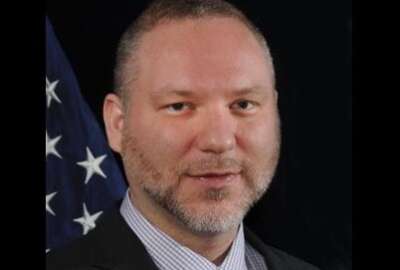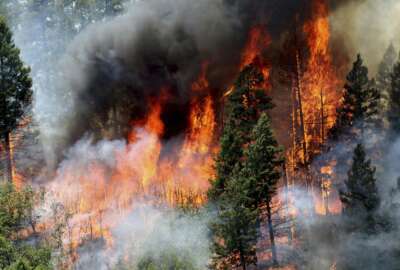
Using IoT devices to prevent wildfires
Wildfire season is months off, but the Department of Homeland Security's Science and Technology Directorate is at work on a program to see how internet of things...
Best listening experience is on Chrome, Firefox or Safari. Subscribe to Federal Drive’s daily audio interviews on Apple Podcasts or PodcastOne.
Wildfire season is months off, but the Department of Homeland Security’s Science and Technology Directorate is at work on a program to see how internet of things technology can reduce the threat. It’s a project of the directorate’s Smart City Internet of Things Innovation Labs, and senior science adviser for resilience David Alexander joined Federal Drive with Tom Temin for more.
Interview transcript:
Tom Temin: Mr. Alexander, good to have you on.
David Alexander: Good to be here this morning.
Tom Temin: Tell us about this program, how you are using internet of things to mitigate wildfires. Give us a sense of the context of what’s going on here.
David Alexander: Sure, let me give you a little bit of context, larger context. So our internet of things investment in wildland fire research really is part of a larger research and development agenda in support of the Federal Emergency Management Agency. This is particularly related to the biggest firefighting challenge facing the U.S. Wildland fires are occurring all across the country. They’re not unique to one area. Just about every state within the U.S. has wildland fires. In 2018 alone, we had over 52,000 wildland fires in the country. Over this time span, not only have we seen an increase in the number of declared wildland fire disasters but we’ve seen an increase in the destruction, that those wildland fires have caused, an increase in the number of fatalities – death caused by wildland fires as well as loss in properties, both residences, businesses and critical infrastructure being impacted. So FEMA asked [Department of Homeland Security] science and technology to look at where we can inject new R&D, new science and technology research and development, to address this growing challenge facing the nation.
Tom Temin: You’re looking at detecting the initiation of fires as a way to get to them earlier. Is that the point of this program?
David Alexander: Absolutely. That is one part of the program. We identified seven key areas of opportunity to inject new research and development against the growing wildland fire challenge in the country. Of course, early fire detection and the ability to track more precisely and in more near real time the propagation of those fires, the movement and growth of those fires is an important aspect. Being able to do that with a variety of sensors, whether it’s sensors that are deployed in specific locations that are high risk, no different than us deploying flood sensors in high risk stream locations, or it’s using new unmanned aerial surveillance systems or new Earth observing systems, meaning high revisit rate, high accuracy satellites that can detect a fire within 10 minutes or so and being able to transmit that information to first responders and firefighting forces on the ground, to get ahead of the conditions.
Tom Temin: You’ve partnered with four sensor companies from around the world, really – San Francisco, Hamburg, Germany; Rockville, Maryland; and New Hampshire. And they are providing sensors. How will this particular piece work, the internet of things part?
David Alexander: This particular piece is looking at where we can have In-Situ sensors, these are sensors that employed on the ground in high risk locations that can give us early warning, an indication of fires that are affecting those sensitive areas. They will then augment additional information that we’re getting from satellites, particularly satellites that we’re partnering and collaborating with NOAA and the National Weather Service, as well as other aerial surveillance systems that were leveraging in partnership with the U. S. Forest Service and in fact, the State National Guards in many of these locations or venues. So with the key aspect of our research and development strategy for wildland fires.
Tom Temin: We’re speaking with David Alexander. He’s senior science adviser for Resilience in the Smart City Internet of things Innovation labs. That’s part of DHS’ Science and Technology Directorate, and tell us about what’s going to happen. You put sensors on the ground in the trees, or how does this all work?
David Alexander: We’ll put sensors. Typically, they will be situated on a ground or facility so that we get good line of sight, better viewing angles and more open detection for those sensors will produce a better result. They’ll be detecting different conditions within the air that they’re observing from their viewing angle and then interpreting whether or not a fire condition is occurring within that vicinity. They are outdoor sensors, so they are acclimated towards being able to detect conditions that would be conducive to outdoor wildland fires. We will be testing them to a variety of use cases to ensure that, you know, we can identify false positives to evaluate the potential for these sensors to be expanded and modified to support wildlands urban fire detection. It’s also important to note that the sensors not only provide early detection. But early detection enables faster evacuation, not just faster response from responders.
Tom Temin: Sure and these are radio devices that can send back data continuously, in other words, to some sort of a gathering point?
David Alexander: Yes, that is correct. So they will be multi-modal. So what makes them both an internet of things capability is that while they use the internet to relay and transmit and communicate with each other, they’re using communications channels such as radio satellite. Or they could be wired into a facility’s local network. And that’s to ensure that there is resilience in those devices. If
one mode of communication fail, they have the ability to pick up another mode of communication and still continue to relay the information that they’re detecting.Tom Temin: And what is it they are detecting? I imagine temperature, maybe in one case, or smoke in another. Could they, how about the aridity or dryness of the conditions?
David Alexander: Correct. So the intent is that they would be able to detect a variety of measures that is reflective of a fire event or maybe conducive to potential fire event. Those include not just smoke, so especially particulate matter that’s in the air. It could be smoke. It could be carcinogens. So those are the conditions that the smoke would actually be producing from the fire. What you smell when you burn wood is the effluent that discharges from the burning of that wood. It’s not just the smoke that you see. So these sensors are attuned and acute to being able to pick up those types of particular matter within the air. We also have asked for them to be able to pick up on humidity conditions to determine how dry the air is. Pick up temperature conditions and other aspect that are a known triggers for not the ignition of a fire but influencing the growth of a fire once ignition occurs.
Tom Temin: So this could have a almost predictive quality or algorithmic component, such that you might be able to learn more about when a fire is going to occur before it does?
David Alexander: The potential for the research going forward is if you start to perfect and produce more affordable sensors that you can densely deploy in high risk locations, then you can use the information that they’re collecting in near real time with artificial intelligence, and other machine learning science to come up with predictive analytics on how the fire is behaving, where the fires may be moving and then that complements the observing data that you’re getting from aerial assets or satellite assets. One of the key deficiencies that was identified in our operational requirements and capability analysis effort was that preparedness in the ability not just to detect but forecast, and then track the movement of those fires, was a critical area of need both for first responders and critical infrastructure operators, but also for evacuation planners and mobilizing and optimizing evacuation routes to get citizens out of harm’s way.
Tom Temin: And from a program standpoint, as you get started, where are you doing this? What kinds of acreage are you able to cover as you do this research?
David Alexander: So right now we’re gonna have some prescriptive, very narrowly-defined initial use cases built within our relationship with SETI and the George Mason University. The intent is that we would then expand our experiments into wild land fire areas through partnerships with the communities that are affected. We are in discussions with a number of communities, and those occur both west coast, east coast as well as within the southwest and middle of the country, and that’s intentional. We want to make sure that we’re experimenting and testing the sensors from a variety of geography as well as a variety of conditions because not all wildfires are the same and not all the areas that wild fires occur at are the same. And that’s an important aspect of the larger program in itself.
Tom Temin: And do you expect to have something on the ground or tacked up, I should say – I don’t know, I guess they’re all over the place – for the upcoming fire season: April, May, June timeframe?
David Alexander: We are working with several communities in addition to the work that we’re testing on new sensors. So we are working with communities on validating and enhancing their existing wildland fire networks. So that is something that will be occurring over the summer. That includes not just leveraging our partnership with the National Weather Service, and their GOES satellite system, with some firefighting communities to get detection information out faster. But it also includes leveraging some thermal camera networks and Doppler radar networks as well. So we have a very sophisticated and rich R&D initiative around wildland fires And it’s to leverage existing technologies that can be augmented or modified and enhanced as well as injecting new technologies that can expand capabilities for the larger fire community.
Tom Temin: David Alexander is senior science adviser for resilience in the Smart City Internet of Things Innovation Labs at the DHS Science and Technology Directorate. Thanks so much for joining me.
David Alexander: Thank you.
Tom Temin: We’ll post this interview along with a link to more information at federal news network dot com slash federal Drive. Hear the Federal Drive on demand and on your device. Subscribe at Apple Podcasts or Podcastone.
Copyright © 2025 Federal News Network. All rights reserved. This website is not intended for users located within the European Economic Area.



